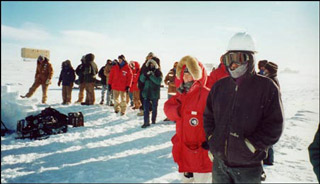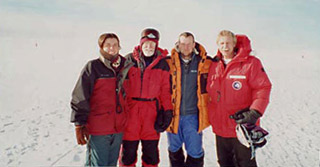The First South Pole Marathon
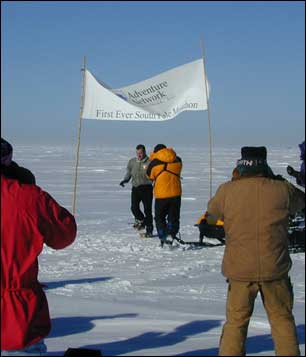
Richard Donovan, being photographed as he is the first to cross the finish line at Pole (RD)
|
Originally there were six participants: Richard Donovan (age 35, Galway, Ireland, who was embarking on a plan to run 7 marathons on all 7 continents in 2002), Ute Grüner (55, Bonn, Germany, the only woman participant--she'd never run a marathon before but had been in a skiing expedition across Greenland); Dean Karnazes (38, San Francisco, CA, perhaps the favorite, he'd done many ultramarathons including solo completion of the 199-mile Providian Relay from the Napa Valley to Santa Cruz normally run by a 12-person team), Don Kern (45 Martin, MI, who'd completed 67 marathons), and Brent Weigner (52, Cheyenne, WY, another seasoned ultramarathon runner), and Raphael (Rafi) Rottgen (29, a German living in London). The original plans were to fly from PA to PH on 4 January 2002 for 2 nights, fly to the starting point 26.2 miles from Pole on the 6th, run the marathon on the 8th, and end up back in PA by the 11th. Of course that didn't work out. They ended up arriving at PH late in the evening of 7 January (times on this page are Chilean/PH daylight saving time, UTC-3, or 16 hours behind Pole/NZ time). Their flights to the starting point got cancelled several times due to weather...the group stayed at PH until the 17th...by this time Rafi had to cancel out and try to get home, as he'd missed too much work already. The other 5 participants and guides flew south; after stops at the Thiel refueling site and at Pole, they reached camp near the starting point after midnight on the 17th. The plan was to acclimate to the altitude for a couple of days, during which time the organizers were to set up the flagged route and aid stations every 5 miles. These were to be supported by two aircraft, a Cessna and a Basler, but it turned out that only the Basler was available. On the 19th they had the "media" start with filmed action shots and interviews. The race started on 20 January; the weather was partly cloudy, -25ºF, and almost no wind. And soft snow. But after the first couple of miles the visibility turned lousy, and the race was canceled for the day. On the morning of the 21st, the sky was overcast with poor visibility, and it became apparent that the aircraft support might be limited. And the final pre-race discussions began...to be cussed, disputed, and further discussed later (understand that I wasn't there, and I'm relying upon the accounts and news reports from those who were--links at the bottom of this page). Because of the limited support capability (only by snowmobile), the organizers decided that if any one of the participants had to drop out for any reason, the remainder of the race would be cancelled for all. Ute and Don, who felt they might be the slower runners, opted to be flown to Pole and complete an out-and-back half marathon. Richard, Brent, and Dean, at the suggestion of the organizers, supposedly agreed that most of the marathon distance would be run "expedition style," staying close together until the last few miles. And finally, the decision was made by Richard and Brent that they would use the two pair of snowshoes which were available, while Dean competed in running shoes. Interestingly, this was the first time that Richard had ever used snowshoes, but he decided to do so because of his injured and weak knee. The three marathoners started at 1800 on 21 January. Karnazes took off quickly, but was overtaken by Donovan after the first six miles, and maintained the lead ever since. About 3 miles from the finish he became confused by the lack of route markers...and poor visibility prevented him from seeing the station. Still, he ended up finishing 27 minutes ahead of Karnazes and Weigner. | |
|
Views of the finish line in the dark sector and a group of waiting Polies. The unfinished DSL is in the background (RD). After completing the marathon, Brent, Richard, and Dean went back onto the course to attempt a 45K event. The results: 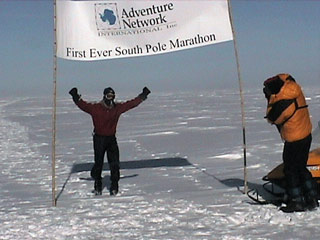
At right, another finisher crosses the line; I believe this is Don Kern (common drive photo).
After the results were announced, the discussions began. The three marathoners disagreed as to the nature of their pre-race pact about non-competition. The snowshoes--supposedly they belonged to Karnazes; did they give Donovan an unfair advantage? And then there was the prize...at one point some of the competitors said they'd been told they were competing for a $25,000 first prize--which happened to be equal to the entry fee. It was argued that the $25,000 purse was the maximum, not a fixed amount. And while the initial ANI press release had announced that Donovan was the winner, Doug Stoup declared that there had been a "runners" division and a "snowshoe" division. ANI ultimately decided that all five were "winners" and awarded them $3,000 each. 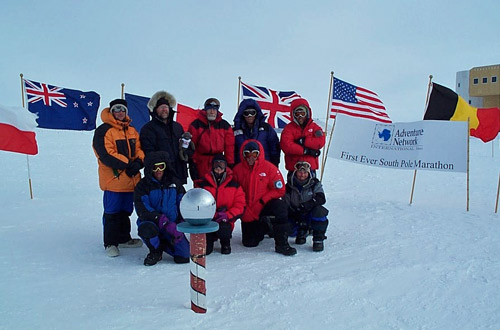 The obligatory hero shot--the participants are in the back row. From left: Richard Donovan, Don Kern, Brent Weigner, Ute Grüner, and Dean Karnazes (WY) As these discussions were underway, the group had two days at Pole to recuperate, tour the station, visit the store to purchase souvenirs and Scotch, and take their hero shots--some of which are not suitable for this web site. On 23 January they were flown back to PH where they continued their recovery and celebrated a bit more. The group ultimately arrived back in PA at 0100 on the 26th. References and sources of additional information include this account as well as a race diary by Richard Donovan (RD) (archived sites). (Note that the links on these pages do not work correctly--the images and additional pages can be navigated from this archive directory). Richard would go on to complete a marathon (or longer) on all seven continents as well as at the North Pole in 2002, winning on three of them. More recently he's been the organizer as well as a frequent participant in the Antarctic Ice Marathon. Another excellent diary is that of Don Kern, which was published in the May/June 2002 issue of Marathon and Beyond. Here's Don's home page; as of march 2017 he'd run over 310 marathons! Diary entries from Brent and Don (as well as the group hero shot at the Ceremonial Pole) also appeared on this page published by the Cheyenne (WY) Track Club. Also of great interest are two articles from Sports Illustrated--the first one published 29 April 2002, which describes the concerns about the offered vs awarded prize money, and the second one, published on 16 June 2003 titled "A Long Running Feud" with further updates on the controversy. A couple of historical notes...the first marathon at Pole (at least that I'm aware of) was "held" on Patriots Day in 1981 (20 April, the date of the Boston Marathon) by Chuck Huss, well, on a treadmill in Biomed. More recently, the winners of the Round the World Race would travel to McMurdo to compete in the marathon there. And beginning in January 2011 (when flights to McMurdo were cancelled) the first of the actual outdoor South Pole marathons was conducted. | |
 This was the first and only South Pole Marathon conducted by
This was the first and only South Pole Marathon conducted by 
